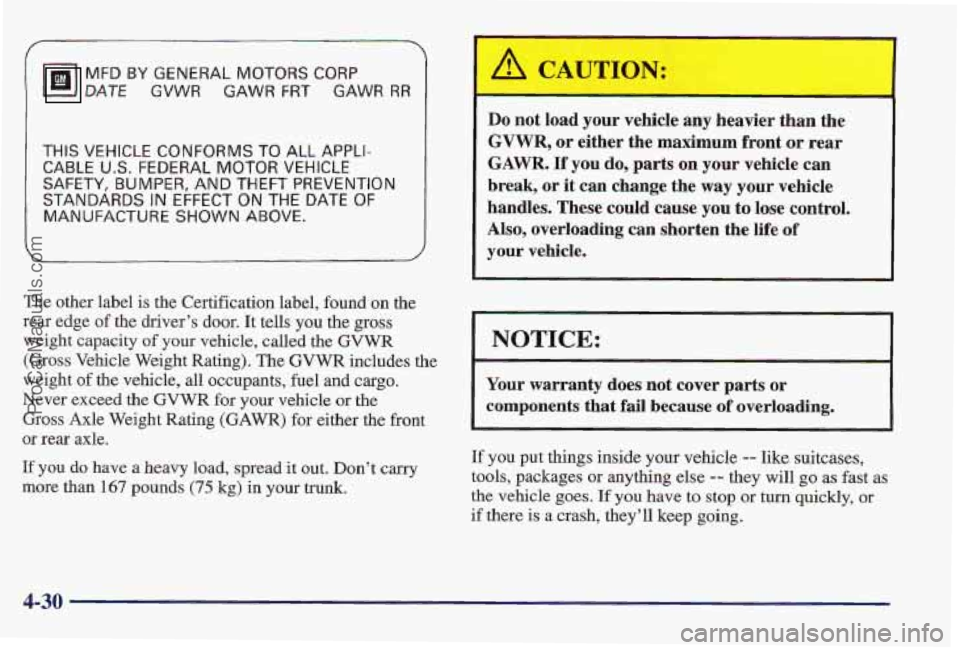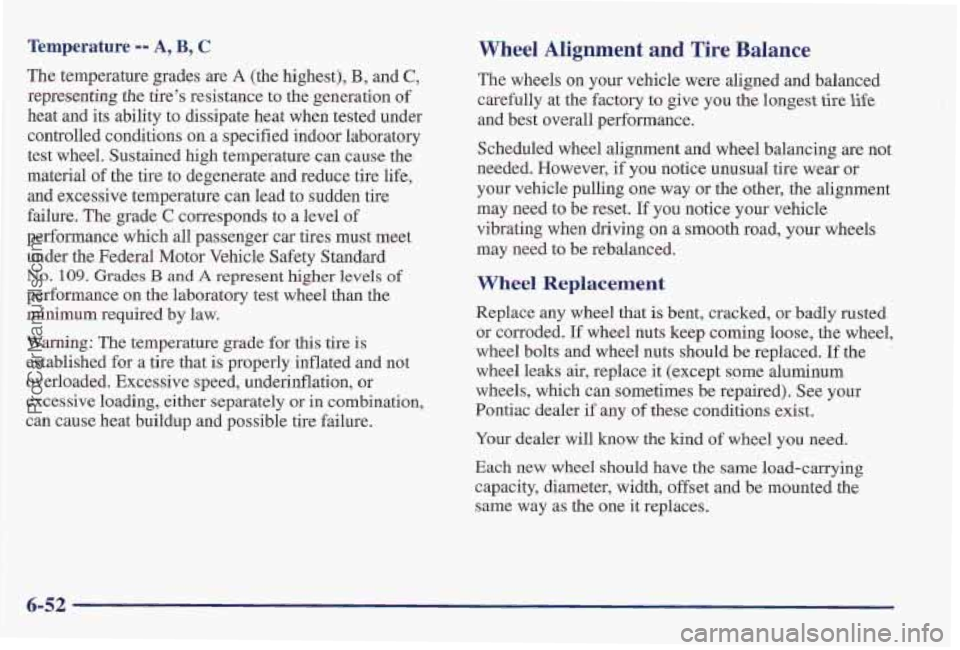1997 PONTIAC PONTIAC load capacity
[x] Cancel search: load capacityPage 223 of 419

Run your engine only as long as you must. This saves
fuel. When you run the engine, make it
go a little faster
than just idle. That
is, push the accelerator slightly. This
uses less fuel for the heat that you get and it keeps the
battery charged. You will need a well-charged battery
to restart the vehicle, and possibly for signaling later on
with your headlamps. Let the heater run for a while.
Then, shut the engine off and close the window almost
all the way to preserve the heat. Start the engine again
and repeat this only when you feel really uncomfortable
from the cold. But do it as little as possible. Preserve the
fuel as long as
you can. To help keep warm, you can get
out of the vehicle and do some fairly vigorous exercises
every half hour or
so until help comes.
Loading Your Vehicle
/@ OCCUPANTS
VEHICLE CAP. WT.
TIRE-LOADING INFORMATION
FRT. CTR.
RR. TOTAL LBS. KG
~-
MAX. LOADING & GVWR SAME AS VEHICLE
CAPACITY
WEIGHT XXX COLD TIRE
TIRE
SIZE SPEED PRESSURE
RTG PSI/KPa
FRT.
RR.
SPA.
IF TIRES ARE HOT, ADD 4PS1/28KPa
SEE OWNER'S MANUAL FOR ADDITIONAL
INFORMATION
Two labels on your vehicle show how much weight it
may properly
carry. The Tire-Loading Information label
is on the inside of the trunk lid. The label tells you the
proper size, speed rating and recommended inflation
pressures for the tires on your vehicle.
It also gives you
important information about the number of people that
can be in your vehicle and the total weight you can
carry. This weight is called the vehicle capacity weight
and includes the
weight of all occupants, cargo and all
nonfactory-installed options.
ProCarManuals.com
Page 224 of 419

MFD BY GENERAL MOTORS CORP
DATE GVWR GAWR FRT GAWR RR
THIS VEHICLE CONFORMS TO ALL APPLI-
CABLE U.S. FEDERAL MOTOR VEHICLE
SAFETY, BUMPER, AND THEFT PREVENTION
STANDARDS IN EFFECT ON THE DATE OF
MANUFACTURE SHOWN ABOVE.
The other label is the Certification label, found on the
rear edge of the driver’s door. It tells you the gross
weight capacity
of your vehicle, called the GVWR
(Gross Vehicle Weight Rating).
The GVWR includes the
weight of the vehicle, all occupants, fuel and cargo.
Never exceed the GVWR for your vehicle or the
Gross Axle Weight Rating
(GAWR) for either the front
or rear axle.
If you do have a heavy load, spread it out. Don’t carry
more than 167 pounds (75 kg) in your trunk.
Do not load your vehicle any heavier than the
GVWR, or either the maximum front or rear
GAWR. If you do, parts on your vehicle can
break, or it can change the way your vehi’cle
handles. These could cause you to lose control.
Also, overloading
can shorten the life of
your vehicle.
NOTICE:
Your warranty does not cover parts or
components that
fail because of overloading.
If you put things inside your vehicle -- like suitcases,
tools, packages or anything else
-= they will go as fast as
the vehicle goes. If you hav’e to stop or turn quickly, or
if there is a crash, they’ll keep going.
4-30
ProCarManuals.com
Page 226 of 419

?‘hat’s me reason for this part. In it are many
Many of these are important
for your safety and that of
your passengers. So please read this section carefully
before you pull a trailer.
NOTICE: time-tested, important trailering tips and safety rules.
Pulling a trailer improperly can damage your
vehicle and result in costly repairs not covered
by
your warranty. To pull a trailer correctly, follow Load-pulling components such as the engine, transaxle,
the advice in this part, and see your Pontiac wheel assemblies and tires are forced to work harder
dealer for important information about towing a against the drag of the added weight. The engine is
trailer with your vehicle. required to sperate at relatively higher speeds and under
greater loads, generating extra heat. What’s more, the
trailer adds considerably to wind resistance, increasing
If You Do Decide To Pull A Trailer
If you do, here are some important points:
Do not tow a trailer if your vehicle is equipped with the pulling requirements.
3800 (L67) supercharged engine.
Your vehicle can tow
a trailer if it is equipped with
proper towing equipment.
To identify what the vehicle
trailering capacity is for your vehicle, you should read
There are many different laws, including speed limit
the information in “Weight of the Trailer” that appears restrictions, having to do with trailering. Make sure
later
in this section. But trailering is different than just your rig will be legal, not only where you live but
driving your vehicle by itself, Trailering means changes also where you’ll be driving.
A good source for this
in handling, durability and fuel economy. Successful, information
can be state or provincial police.
safe trailering takes correct equipment, and it has to be
Consider using a sway control. You can ask a hitch
used Droperly. dealer about
sway controls.
4-32
ProCarManuals.com
Page 227 of 419

0
0
0
Don’t tow a trailer at all during the first 1,000 miles
(1 600 km) your new vehicle is driven. Your engine,
axle or other parts could be damaged.
Then, during the first
500 miles (800 km) that you
tow a trailer, don’t drive over
50 mph (80 km/h) and
don’t make
starts at full throttle. This helps your
engine and other parts of your vehicle wear in at the
heavier loads.
Obey speed limit restrictions when towing a trailer.
Don’t drive faster than the maximum posted speed
for trailers (or no more than
55 mph (90 kdh)) to
save wear
on your vehicle’s parts.
Three important considerations have to
do with weight:
0 the weight of the trailer,
the weight of the trailer tongue
and the total weight on your vehicle’s tires.
Weight of the Trailer
How heavy can a trailer safely be?
It should never weigh more than
1,000 pounds (450 kg).
But even that can be too heavy.
It depends on how you plan to use your rig. For
example, speed, altitude, road grades, outside
temperature and how much your vehicle is used to pull a trailer
are all important. And, it can also depend on any
special equipment that you have on your vehicle.
You can ask
your dealer for our trailering information or
advice, or you can write us at:
Customer Assistance Center
Pontiac Division, One Pontiac Plaza
Pontiac, MI 48340-2952
In Canada, write to:
General Motors of Canada Limited
Customer Communication Centre
1908 Colonel Sam Drive
Oshawa, Ontario L1H 8P7
Weight sf the Trailer Tongue
The tongue load (A) of any trailer is an important
weight to measure because it affects the total capacity
weight
of your vehicle. The capacity weight includes the
curb weight of the vehicle, any cargo you may carry in
it, and the people who will
be riding in the vehicle. And
if you will tow a trailer, you must subtract the tongue
load from your vehicle’s capacity weight because your
vehicle will be carrying that weight, too. See “Loading
Your Vehicle” in the Index for more information
about
your vehicle’s maximum load capacity.
4-33
ProCarManuals.com
Page 322 of 419

Temperature -- A, B, C Wheel Alignment and Tire Balance
The temperature grades are A (the highest), B, and C,
representing the tire’s resistance to the generation of
heat and its ability to dissipate heat when tested under
controlled conditions
on a specified indoor laboratory
test wheel. Sustained high temperature can cause the
material
of the tire to degenerate and reduce tire life,
and excessive temperature can lead to sudden tire
failure. The grade
C corresponds to a level of
Performance which all passenger car tires must meet
under the Federal Motor Vehicle Safety Standard
No. 109. Grades B and A represent higher levels of
performance on the laboratory test wheel than the
minimum required
by law.
Warning: The temperature grade for this tire is
established for a tire that
is properly inflated and not
overloaded. Excessive speed, underinflation, or
excessive loading, either separately or in combination,
can cause heat buildup and possible tire failure. The wheels
on your vehicle were aligned and balanced
carefully at the factory to give you the longest
tire life
and best overall performance.
Scheduled wheel alignment and wheel balancing
are not
needed. However,
if you notice unusual tire wear or
your vehicle pulling
one way or the other, the alignment
may need to be reset.
If you notice your vehicle
vibrating when driving on
a smooth road, your wheels
may need to be rebalanced.
Wheel Replacement
Replace any wheel that is bent, cracked, or badly rusted
or corroded. If wheel nuts keep corning loose, the wheel,
wheel bolts and wheel nuts should
be replaced. If the
wheel leaks air, replace it (except some aluminum
wheels, which can sometimes be repaired). See your
Pontiac dealer if any of these conditions exist.
Your dealer will know
the kind of wheel you need.
Each new wheel should have the same load-carrying
capacity, diameter, width, offset and be mounted the
same way as the one it rep1,aces.
6-52
ProCarManuals.com